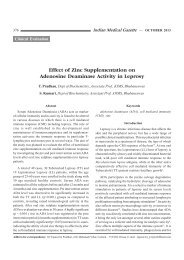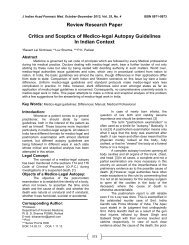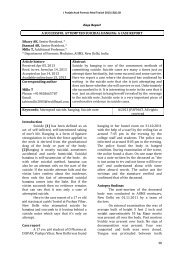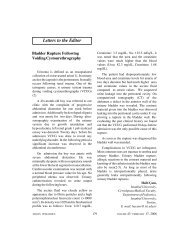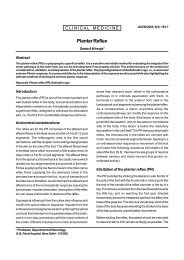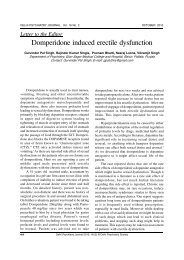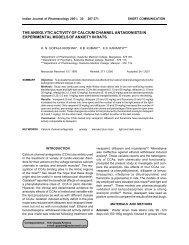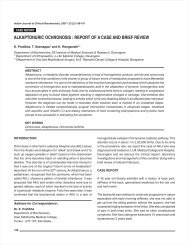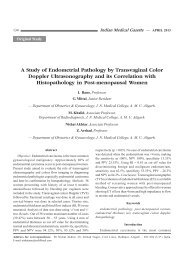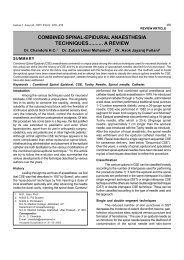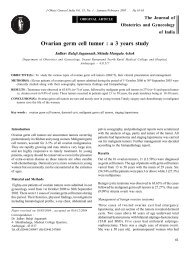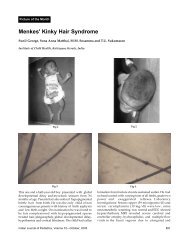Diabetic Neuropathy: Current Concepts - medIND
Diabetic Neuropathy: Current Concepts - medIND
Diabetic Neuropathy: Current Concepts - medIND
Create successful ePaper yourself
Turn your PDF publications into a flip-book with our unique Google optimized e-Paper software.
iv. Defects in nerve regeneration<br />
Peripheral nerves have abundant receptors for<br />
nerve growth factor (NGF). NGF is responsible<br />
for regeneration of nerves. Circulating NGF<br />
concentration is reduced in diabetic patients<br />
with neuropathy 34 . Treatment with NGF has<br />
improved peripheral nerve function. Insulin like<br />
growth factor and neurotrophin – 3 also helps<br />
in regeneration of nerves.<br />
Thus regardless of the exact pathogenesis of<br />
diabetic neuropathy, it is now clear that chronic<br />
hyperglycaemia has a pivotal role in the<br />
pathogenesis of diabetic neuropathy. The<br />
earliest effects of hyperglycaemia are generally<br />
metabolic while electrophysiologic and<br />
morphological changes are considered to be<br />
a late occurrence. Intensive control of blood<br />
sugar reduces the occurrence of clinical<br />
neuropathy. However, once diabetic<br />
neuropathy is established, significant recovery<br />
usually does not occur, even with good<br />
glycaemic control.<br />
Diagnosis of diabetic neuropathy (DN)<br />
The diagnosis of DN can be made on clinical<br />
examination but subsequently it needs to be<br />
confirmed by investigations (non-invasive/<br />
invasive). The diagnosis of DN in time is very<br />
important because effective intervention will be<br />
possible only during the subclinical or early phase<br />
of dysfunction. There are two approaches for<br />
diagnosis of DN (i) Traditional (ii) Newer.<br />
A. Traditional approaches<br />
1. Clinical examination : The traditional<br />
approach to diagnose DN, requires careful<br />
clinical assessment of “Signs” of sensory, motor,<br />
and autonomic function deterioration. Clinical<br />
examination yields a “valid” index of DN quickly,<br />
but inter-examiner variability limits the<br />
reproducibility and reliability of test results 35 .<br />
2. Test of sensory function : In-depth sensory<br />
examination is required because routine<br />
clinical examination will only detect<br />
abnormalities at a relatively advanced stage<br />
and selective involvement of fibre is not rare.<br />
Patient co-operation is mandatory for clinical<br />
examination.<br />
a. Vibration perception threshold (VPT) : It is<br />
usually assessed by 128 Hz tuning fork. Only<br />
large fibres are assessed by the test. Vibration<br />
perception is usually assessed at the tip of great<br />
toe or over lateral malleolus. Nowadays more<br />
sophisticated instruments are available for<br />
assessment of vibration perception threshold,<br />
e.g., biosthesiometer, vibrameter.<br />
Biosthesiometer uses an electromagnet to<br />
activate a spring loaded stimulator, according<br />
to an arbitrary scale from 0-50 volts. The risk<br />
of foot ulceration is increased 3-4 fold if the<br />
vibration perception threshold exceeds 25<br />
volts. Vibrameter is also based on the principle<br />
of biosthesiometer but results are given directly<br />
in mm of probe displacement.<br />
b. Light touch sensation : These sensations are<br />
carried by large myelinated Aα and Aβ fibres.<br />
Nylon Semmes Weintein mono-filaments are<br />
used for light touch assessment. A series of<br />
increasingly thick filaments are tested, and the<br />
threshold at which the first one can be felt when<br />
buckling is noted. The inability to feel the 10<br />
gm filament indicate that patient is prone to<br />
foot ulceration.<br />
c. Thermal thresholds : Warm and cold<br />
sensations should be tested separately. The<br />
former is mediated by the smallest<br />
unmyelinated C fibres and the latter by small<br />
myelinated Aδ fibres. The equipment used for<br />
thermal threshold assessment are expensive<br />
and mostly used for research purposes. Pain<br />
threshold can be determined either by<br />
application of high or low temperature or by<br />
using the “Pinchometer” or a series of weighted<br />
needles.<br />
d. Tests for autonomic function : Bedside<br />
cardiovascular tests have been developed to<br />
evaluate cardiovascular autonomic neuropathy<br />
(table-III) 36 . These tests are extremely sensitive<br />
310 Journal, Indian Academy of Clinical Medicine Vol. 2, No. 4 October-December 2001



